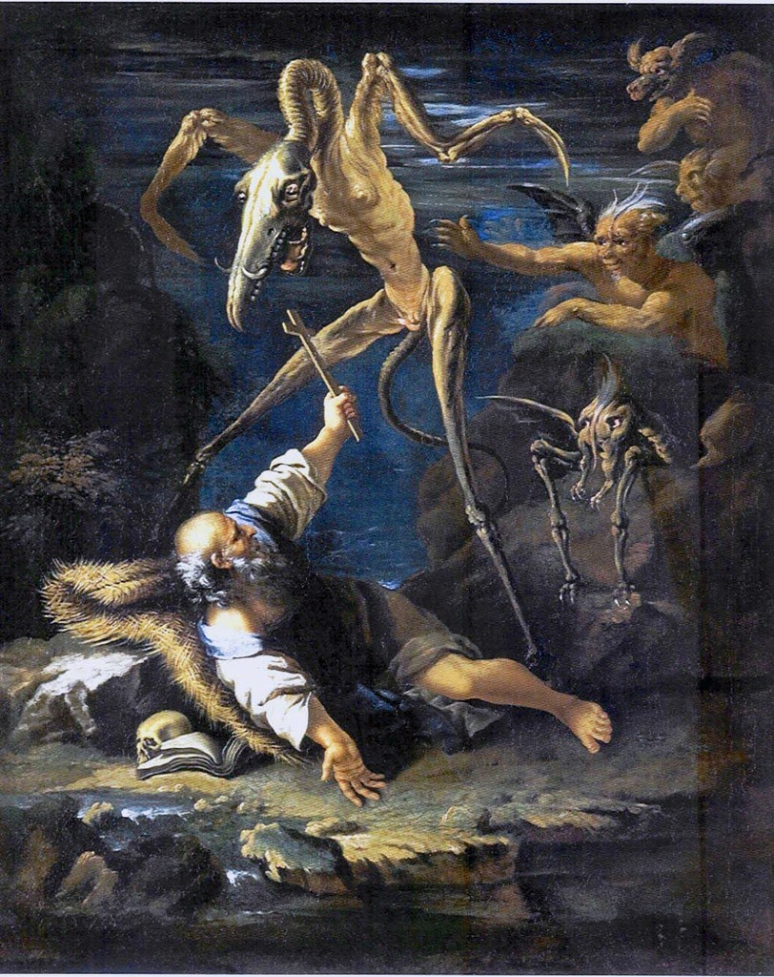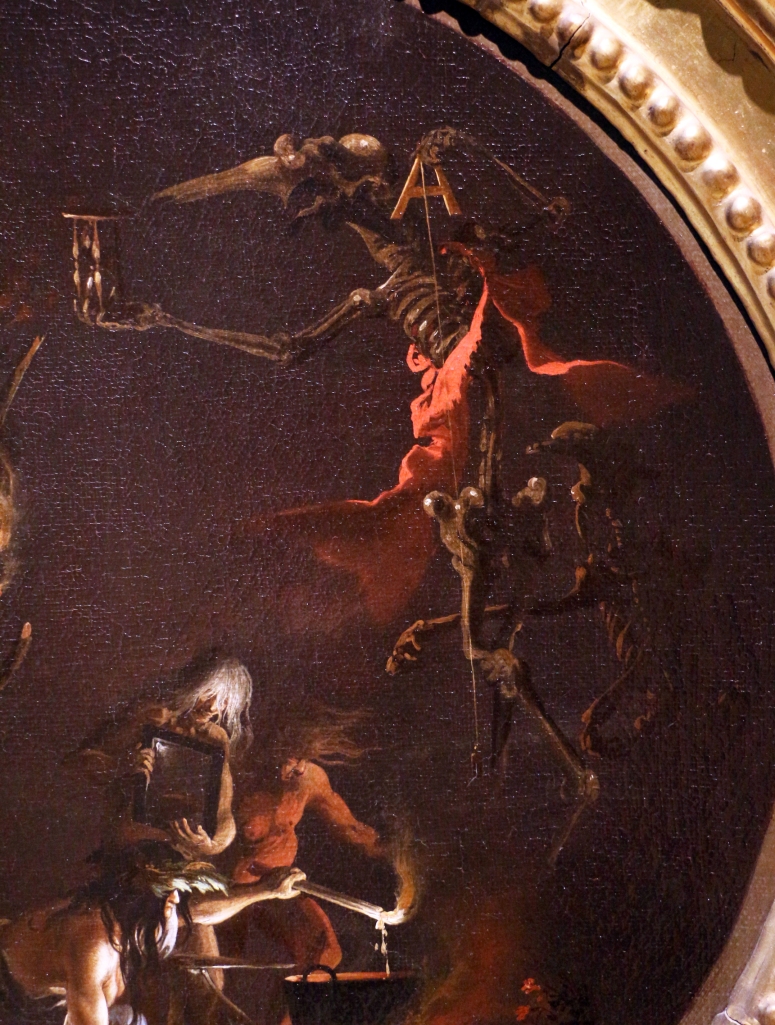Salvator Rosa – A forerruner of Romanticism
Fifteen months ago I started a series of posts on this gripping and fruitful subject –one of the most depicted in Western art history aside of the biblical classic scenes–. From then on I have added some half a hundred paintings, drawings and engravings to my already extensive stock, and this has, somehow, discouraged me to keep on posting, just out of the sheer ammount of material worthy to comment and the growing scarcity of time available for it.
Anyway, already in my first post, after the pertinent introduction to the legend of Saint Anthony and my comments on two 20th century masterworks relative to it, I showed two great older paintings: one by Mathias Grünewald (1512-1516) and the other by Salvator Rosa (1645), assuring that I would comment them in a forthcoming post… Well, here I am, with much delay, but willing to be true to my word.
Salvator Rosa, born in the outskirts of Naples in 1615 was a ground-breaking artist in several aspects and a precursor of Romanticism. Even more: an unrecognized source of inspiration for Francisco de Goya, in the early 19th century, with regard to startling (and quite scaring) representations of witches, witchcraft, aquelarres and black masses; and a fortunately recognized influence on William Turner with regard to landscape painting. (The clue to these opposed facts is that Turner frankly acknowledged his debt to the work of Rosa, while Goya –as a typically haughty and embittered Spaniard– did not (at least as far as I know)).
Beyond the usual strangeness of Rosa’s favourite themes (ugly and nasty witches and bandits, wilderness and magic), “La Tentazione di Sant’Antonio” is a great wonder for its particular iconography, which makes it one of the most extravagant and spectacular creations of all Baroque painting.
.

[Pinacoteca ‘Rambaldi’ di Villa Luca a Coldirodi, Sanremo, Italy]
.
This painting, 373 years old, brings the horror of evil to a climax never achieved so far by any other work on this theme (aside of some imagery by Hieronymus Bosch): at evening or night, in a rocky place, Saint Anthony is distracted from meditation by the sudden appearance of a really weird monster and some other demonic figures. He rolls on the ground, holding a cross as a shield against them. In the foreground, below his straw mat, we see the Gospel and a skull –symbol of any good hermit’s meditation on the afterlife and his doom to die in this world–. Among the forces of evil, stands a sexually mixed, perhaps hermaphrodite creature that, while having its antecedents in Bosch and several medieval bestiaries, holds a most stricking appearence of modernity (it quite recalls me the famous “Alien” by Ridley Scott). Its nature consists of elements from different animals: the body ressembles the skeleton of a bird, the head is that of an equid with several boar tusks, the snaking tail recalls that of a rat. It has a navel (and so, a mother, sometime!), tities and a very tiny cock (!). Its presence and fierce attitude arouses loathing, and maybe, actual fear, if you are a bit childlike like I am… It is The Devil; an awful nightmare far from the goat-like hybrids, the half-dragons, the mystical creatures with large, still angelical wings, or the foxy-looking and tempting women of traditional religious iconography.
Rosa depicted quite a few other similarly aviform devils during his life (some of them very scaring!) and so, he connected the isolated genius of Bosch (150 years before him) with the work of some outstandingly daring painters after him, like Goya, and the early 20th century Surrealists; very especially, Max Ernst (of whom you may see his “Temptation of Saint Anthony” (1945) in the same introductory post I linked to above).
As for the figure of the Saint in Rosa’s oil, I clearly observe the influence of the contemporary Valencian painter, also settled in Naples, Josep de Ribera (1591-1652), italianized as Giuseppe Ribera, who is one among the greatest painters of that period and one of the main representatives of Tenebrism (and thus, to a point, a precursor of Romanticism as well). Ribera was equally very fond of showing cruelty, martyrdoms and other, most realistic, truly horror-inspiring scenes from the classical mythology.
.
I post here too a fragment of Rosa’s “The Witches’ Sabbath” (1635/1649), where you may see a couple of devils similar to the Saint Anthony’s one; equally frightful, though less rich and complex in invention:
.
.
And below, two more samples of these skeletal birdlike creatures that Rosa used to associate with Hell and its demons, followed by an enlarged view of the monster at the right side on the medallion:
.
My data about the complementary paintings
1- (Original title unknown to me) – The Witches’ Sabbath (1635/1649), oil on canvas, 87 x 73 cm – Museum of Fine Arts, Huston, TX, USA.
2- “Scena di Streghoneria” – Scene of Witchcraft (1645-1649), oil, 78 x 36 cm – Private Collection.
3 & 4- “Sera”; (terza di “Quattro scene con streghe”) – Evening; third among Four scenes with witches (1645-1649), oil (unknown support and size, but probably wood, and quite small-sized, anyway) – Cleveland Museum of Art, Ohio, USA.





One thing I have always noticed about paintings from past eras is how focused many artists were on evil and the depiction of the devil, like they wanted future generations to be aware of what they could be looking at regarding one’s faith, or lack thereof. Always very detailed paintings as well, the painters certainly didn’t want the viewer to miss anything!!!
LikeLiked by 2 people
Of course evil is and has ever been a main force in human history and all human matters. You already know I hold a different point of view about Judaic and Christian faiths (not to speak of Islam, which I have never been able to understand ), and do not believe in a Devil, but I have no doubt that evil exists within us and around us as a natural trend.
), and do not believe in a Devil, but I have no doubt that evil exists within us and around us as a natural trend.
I’m glad you like these paintings, bro. I like even more that you keep on stopping by and commenting on my scanty posts :)) *Hugs Fondly* !!
LikeLiked by 2 people
I think the inclusion of evil in paintings can serve as a sharp reminder that it does indeed exist. Whether we as humans choose to follow it or good in life it does present itself as an option. So many people over time have lost themselves in it. Look at the prisons filled with murderers and rapists and so many with a blatant disregard for human life. These paintings say so much for a seemingly small space. Thank you for posting these!!! Hugs right back to you, sis!!!!
LikeLiked by 1 person
You’re dearly welcome, as always, brother 🙂 !
LikeLiked by 1 person
So very very true!
LikeLiked by 2 people
It gets to be overwhelming sometimes, doesn’t it? This is good stuff. It’s worth any time you can offer to it.
LikeLiked by 1 person
Thank yo very much, Emily Rose 🙂 I became overwhelmed while writing my review about Bosch’s St. Anthony’s triptych (the one in Lisbon)… the third, and unpublished, part of this series. After some 20 pages of comments and amazed reflections I was still half-way. I will, most probably, skip Bosch and continue with lesser works, easier to explain.
Awww, and I do appreciate very much your compliment. *HUG*!!
LikeLiked by 2 people
I think it’s safe to say that being overwhelmed by Bosch is a normal condition. lol. I certainly understand stepping back a bit from that, but at the same time, now I’m curious how you would try to explain his work. Still… I get it. That’s not easy at all! *hugs*
LikeLiked by 2 people
Now I know where James Cameron got his inspiration for ALIENS (1986) from!
LikeLiked by 1 person
Yep 🙂 And also Ridley Scott before J. Cameron. Thanks a lot for being here again, my friend ! *BIG HUGS*
LikeLiked by 1 person
I was thinking this must be where Hitchcock got his idea for The Birds… This isn’t anything I’d want to see in my home our place of worship daily!
LikeLiked by 2 people
Haha 🙂 Maybe… Though I think the story by D. du Maurier is rather a metaphor for the air attacks on London during World War II (the Blitz). Anyway, at thet time (1950s) the idea of birds as perverse dangerous beings was mostly spread by Max Ernst, who was a much better known painter than Rosa… but Ernst was probably influenced by Rosa, so… 🙂
LikeLiked by 1 person
Ahh, my Dear Sister – you have SO MANY bits of knowledge in that head of yours! I’m absolutely envious of your ability to link artists, themes and styles. I’d completely spaced on The Blitz… Horrific act that it was.
Petons!
LikeLiked by 1 person
❤ !
(tiny bits of knowledge scattered among big lots of folly, lust and naughtiness 🙂
LikeLiked by 1 person
More reasons to adore you! 😘😜👯
LikeLiked by 1 person
💋 💋 💋 💋 💋 … !!
LikeLiked by 1 person